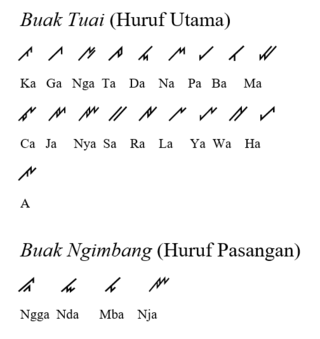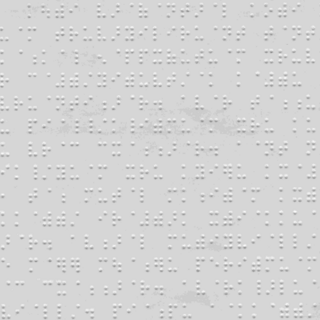Related Research Articles

An alphabet is a standard set of letters written to represent particular sounds in a spoken language. Specifically, letters largely correspond to phonemes as the smallest sound segments that can distinguish one word from another in a given language. Not all writing systems represent language in this way: a syllabary assigns symbols to spoken syllables, while logographies assign symbols to words, morphemes, or other semantic units.
An abjad, also abgad, is a writing system in which only consonants are represented, leaving the vowel sounds to be inferred by the reader. This contrasts with alphabets, which provide graphemes for both consonants and vowels. The term was introduced in 1990 by Peter T. Daniels. Other terms for the same concept include partial phonemic script, segmentally linear defective phonographic script, consonantary, consonant writing, and consonantal alphabet.

An abugida – sometimes also called alphasyllabary, neosyllabary, or pseudo-alphabet – is a segmental writing system in which consonant–vowel sequences are written as units; each unit is based on a consonant letter, and vowel notation is secondary, similar to a diacritical mark. This contrasts with a full alphabet, in which vowels have status equal to consonants, and with an abjad, in which vowel marking is absent, partial, or optional – in less formal contexts, all three types of the script may be termed "alphabets". The terms also contrast them with a syllabary, in which a single symbol denotes the combination of one consonant and one vowel.

The Arabic alphabet, or the Arabic abjad, is the Arabic script as specifically codified for writing the Arabic language. It is written from right-to-left in a cursive style, and includes 28 letters, of which most have contextual letterforms. Unlike the modern Latin alphabet, the script has no concept of letter case. The Arabic alphabet is considered an abjad, with only consonants required to be written; due to its optional use of diacritics to notate vowels, it is considered an impure abjad.

A diacritic is a glyph added to a letter or to a basic glyph. The term derives from the Ancient Greek διακριτικός, from διακρίνω. The word diacritic is a noun, though it is sometimes used in an attributive sense, whereas diacritical is only an adjective. Some diacritics, such as the acute ⟨ó⟩, grave ⟨ò⟩, and circumflex ⟨ô⟩, are often called accents. Diacritics may appear above or below a letter or in some other position such as within the letter or between two letters.
The Hebrew alphabet, known variously by scholars as the Ktav Ashuri, Jewish script, square script and block script, is an abjad script used in the writing of the Hebrew language and other Jewish languages, most notably Yiddish, Ladino, Judeo-Arabic, and Judeo-Persian. In modern Hebrew, vowels are increasingly introduced. It is also used informally in Israel to write Levantine Arabic, especially among Druze. It is an offshoot of the Imperial Aramaic alphabet, which flourished during the Achaemenid Empire and which itself derives from the Phoenician alphabet.
In the linguistic study of written languages, a syllabary is a set of written symbols that represent the syllables or moras which make up words.
Thaana, Tãna, Taana or Tāna is the present writing system of the Maldivian language spoken in the Maldives. Thaana has characteristics of both an abugida and a true alphabet, with consonants derived from indigenous and Arabic numerals, and vowels derived from the vowel diacritics of the Arabic abjad. Maldivian orthography in Thaana is largely phonemic.
The Thai script is the abugida used to write Thai, Southern Thai and many other languages spoken in Thailand. The Thai script itself has 44 consonant symbols, 16 vowel symbols that combine into at least 32 vowel forms, four tone diacritics, and other diacritics.
The Burmese alphabet is an abugida used for writing Burmese. It is ultimately adapted from a Brahmic script, either the Kadamba or Pallava alphabet of South India. The Burmese alphabet is also used for the liturgical languages of Pali and Sanskrit. In recent decades, other, related alphabets, such as Shan and modern Mon, have been restructured according to the standard of the Burmese alphabet
Aleph is the first letter of the Semitic abjads, including Arabic ʾalifا, Aramaic ʾālap 𐡀, Hebrew ʾālefא, North Arabian 𐪑, Phoenician ʾālep 𐤀, Syriac ʾālap̄ ܐ. It also appears as South Arabian 𐩱 and Ge'ez ʾälef አ.

The Rejang script is an abugida of the Brahmic family that is related to other scripts of the region, such as the Batak and Lontara scripts. Rejang is also a member of the closely related group of Ulu scripts that include the script variants of South Sumatra, Bengkulu, Lembak, Lintang, Lebong, and Serawai. Other closely related scripts that are sometimes included in the Surat Ulu group include the Ogan, Kerinci, and Lampung scripts. The script was in use prior to the introduction of Islam to the Rejang area; the earliest attested document appears to date from the mid-18th century CE. The Rejang script is sometimes also known as the KaGaNga script following the first three letters of the alphabet. The term KaGaNga was never used by the users of the script community, but it was coined by the British anthropologist Mervyn A. Jaspan (1926–1975) in his book Folk literature of South Sumatra. Redjang Ka-Ga-Nga texts. Canberra, The Australian National University 1964.
Thai Braille (อักษรเบรลล์) and Lao Braille (ອັກສອນເບຣລລ໌) are the braille alphabets of the Thai language and Lao language. Thai Braille was adapted by Genevieve Caulfield, who knew both English and Japanese Braille. Unlike the print Thai alphabet, which is an abugida, Thai and Lao Braille have full letters rather than diacritics for vowels. However, traces of the abugida remain: Only the consonants are based on the international English and French standard, while the vowels are reassigned and the five vowels transcribed a e i o u are taken from Japanese Braille.

The Saurashtra script is an abugida script that is used by Saurashtrians of Tamil Nadu to write the Saurashtra language. The script is of Brahmic origin, although its exact derivation is not known; it was later reformed and standardized by T. M. Rama Rai. Its usage has declined, and the Tamil and Latin scripts are now used more commonly.
The Romanized Popular Alphabet (RPA) or Hmong RPA, is a system of romanization for the various dialects of the Hmong language. Created in Laos between 1951 and 1953 by a group of missionaries and Hmong advisers, it has gone on to become the most widespread system for writing the Hmong language in the West. It is also used in Southeast Asia and China alongside other writing systems, most notably Nyiakeng Puachue Hmong and Pahawh Hmong.

Pahawh Hmong is an indigenous semi-syllabic script, invented in 1959 by Shong Lue Yang, to write two Hmong languages, Hmong Daw (Hmoob Dawb / White Miao) and Hmong Njua AKA Hmong Leng (Moob Leeg / Green Miao).

Bharati braille, or Bharatiya Braille, is a largely unified braille script for writing the languages of India. When India gained independence, eleven braille scripts were in use, in different parts of the country and for different languages. By 1951, a single national standard had been settled on, Bharati braille, which has since been adopted by Sri Lanka, Nepal, and Bangladesh. There are slight differences in the orthographies for Nepali in India and Nepal, and for Tamil in India and Sri Lanka. There are significant differences in Bengali Braille between India and Bangladesh, with several letters differing. Pakistan has not adopted Bharati braille, so the Urdu Braille of Pakistan is an entirely different alphabet than the Urdu Braille of India, with their commonalities largely due to their common inheritance from English or International Braille. Sinhala Braille largely conforms to other Bharati, but differs significantly toward the end of the alphabet, and is covered in its own article.
ISO 11940-2 is an ISO standard for a simplified transcription of the Thai language into Latin characters.
Kha is the second consonant of Indic abugidas. In modern Indic scripts, kha is derived from the Brahmi letter , which is probably derived from the Aramaic ("Q").